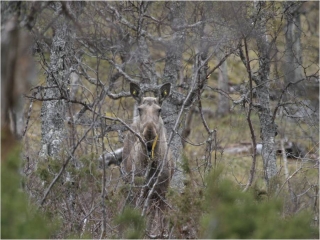Posted 08/9/10
In Sweden, moose are a national symbol, a major game species, and a hazard for car travel, with some 4,500 accidents per year. SILVIS researcher Wiebke Neumann is studying the patterns of moose movement, space use and accident rates using satellite tracking, and spatial statistical analysis. Combining animal movement and accident data will help wildlife and traffic safety management officials to reduce this injuries and deaths to moose and human alike.

Moose are the most numerous large mammal in Sweden and the most important game species. Swedes also take pride in moose as an important national symbol of the Swedish landscape. However moose, with its long legs that place its hefty body well above a car’s hood and its propensity to wander great distances, is a dangerous animal to encounter on a Swedish roadway. You might think of moose as taller, heavier, and more dangerous versions of Wisconsin’s abundant white tailed deer.In fact, it is estimated the accidents with moose, many of them resulting in serious or fatal injuries to humans, number some 4,500 per year in Sweden.Because of the importance of moose for ecology, game, and public safety, moose have attracted much attention from researchers and managers in Scandinavia as well as the US and Canada. A number of researchers have looked into movement patterns of moose, trying to understand, for example, where they forage, mate, and spend their winters. Another body of research has examined accident rates irrespective of moose movement. However, conspicuously absent from this was a thorough examination of how movement patterns relate to vehicle accidents.

The need for a better understanding of this issue was noticed by Wiebke Neumann, a postdoc at SILVIS. Neumann, a native of Hannover Germany who followed her passion for large mammals to Umea, in northern Sweden, joined SILVIS in 2008 to marry her background in wildlife ecology with spatial analysis. While her early research focused on how increasing recreational use of forested areas is affecting moose, she has turned her focus on the relationships between moose and infrastructure development, including roads, houses, and power lines using moose location in different environmental settings in Sweden. The project is collaboration between the moose research group of Goeran Ericsson (Swedish University of Agricultural Sciences) and SILVIS lab. Three key questions she and her colleagues at SILVIS and in Sweden are asking are how infrastructure affects moose movement and space use, what are the drivers for moose movement, and what are the implications for traffic safety.Wiebke uses data from GPS radio collars placed on animals to track movement and then relates this to infrastructure, landscape features and accident rates across Sweden with statistical and spatial analysis. Her research will help managers better understand how human infrastructure affects moose movements and how to better construct roads and place warning signs to minimize dangers to humans and moose alike.In the end, says Neumann, ‘Humans are part of wildlife habitat. And I see moose, really as a model species’. Her research thus contributes to our understanding not only of moose-human interactions, but to how similar questions can be addressed for other species, including white tailed deer.”
Story by Thomas Albright
